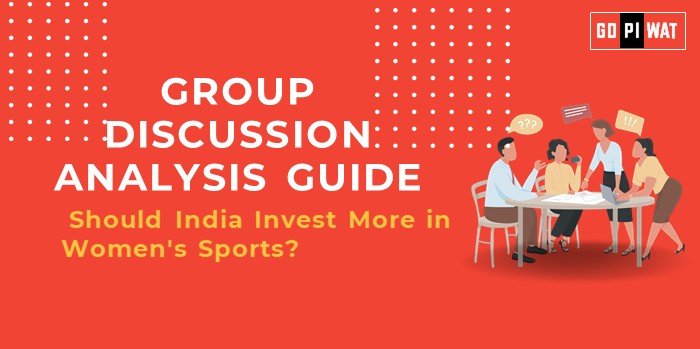📋 Group Discussion Analysis Guide: Should India Invest More in Women’s Sports?
🌐 Introduction to the Topic
- 💡 Opening Context: “Globally, women’s sports have been gaining recognition with increased participation, sponsorships, and viewership. Yet, in India, women’s sports often lack the resources and infrastructure needed to compete on a global scale.”
- 📜 Topic Background: Despite India producing exceptional female athletes like P.V. Sindhu, Mary Kom, and Mirabai Chanu, investments in women’s sports remain significantly lower than in men’s. The debate centers on whether prioritizing these investments could transform India’s global sporting reputation.
📊 Quick Facts and Key Statistics
• 🏅 Olympic Performance: Women contributed 3 out of India’s 7 medals in Tokyo 2020, showcasing their competitive potential.
• 💸 Funding Gap: Women’s sports receive less than 10% of the total sports sponsorship in India.
• 🏃♀️ Participation Rates: Only 28% of athletes in national sports academies are women.
• 🌍 Global Benchmark: USA spends $990 million annually on women’s sports development, compared to India’s approximate $90 million.
• 💸 Funding Gap: Women’s sports receive less than 10% of the total sports sponsorship in India.
• 🏃♀️ Participation Rates: Only 28% of athletes in national sports academies are women.
• 🌍 Global Benchmark: USA spends $990 million annually on women’s sports development, compared to India’s approximate $90 million.
🤝 Stakeholders and Their Roles
- 🏛️ Government: Policies like Khelo India can allocate more funds for women’s sports.
- 💼 Corporate Sponsors: Increasing sponsorships for women-specific leagues and events.
- 📺 Media: Amplifying visibility of women’s sports through consistent coverage and storytelling.
- 🎤 Athletes and NGOs: Advocating for equitable opportunities and inspiring greater participation.
🏆 Achievements and Challenges
✨ Achievements:
- 🥇 Olympic Success: Historic wins in the Olympics and Commonwealth Games highlight the potential of women athletes.
- 🏏 Growth of Women-Centric Leagues: The Women’s Premier League (WPL) in cricket demonstrates commercial viability.
- 🏃 Grassroots Initiatives: Programs like Khelo India promote gender inclusivity.
⚠️ Challenges:
- 🏗️ Inadequate Infrastructure: Many training facilities lack the resources required for women athletes.
- 👨👩👧👦 Societal Biases: Cultural and safety concerns hinder participation.
- 💸 Funding Disparities: Women’s sports receive far less financial support than men’s.
🌍 Global Comparisons:
- 🇺🇸 USA: Title IX legislation significantly increased female participation in sports.
- 🇯🇵 Japan: Investments in women’s sports led to Olympic success in wrestling and other disciplines.
Case Studies:
- 🏏 WPL Cricket: Attracted ₹950 crore in franchise bids, proving commercial viability.
- 🏋️ Haryana’s Policies: Produced top female athletes due to robust state-level initiatives.
🔍 Structured Arguments for Discussion
- ✅ Supporting Stance: “Investing in women’s sports could catalyze social empowerment and improve India’s international sports standing.”
- ❌ Opposing Stance: “Men’s sports still dominate viewership and revenues, making them a more strategic investment priority.”
- ⚖️ Balanced Perspective: “Both men’s and women’s sports need equitable investment to maximize overall sporting potential.”
💡 Effective Discussion Approaches
🔑 Opening Approaches:
- 📊 Statistical Impact: “Women athletes contributed nearly 50% of India’s Olympic medals in 2020, yet their funding is only 10% of men’s.”
- 🌟 Inspirational Start: “Mary Kom, a global icon, began her career in minimal facilities—imagine the potential with better investment.”
🤝 Counter-Argument Handling:
- 📋 Address societal biases with examples of successful reforms like Title IX in the USA.
- ✔️ Highlight how women’s sports leagues like the WPL are bridging financial gaps and changing perceptions.
📈 Strategic Analysis of Strengths and Weaknesses
- ✔️ Strengths: Talent pool, proven international success, growing leagues like the WPL.
- ❌ Weaknesses: Lack of funding, poor grassroots facilities, and societal barriers.
- 🚀 Opportunities: Sponsorship growth, global partnerships, and policy-driven gender equity.
- ⚠️ Threats: Persistent gender stereotypes, financial prioritization of men’s sports.
🏫 Connecting with B-School Applications
- 📚 Real-World Applications: Strategic resource allocation in sports marketing or developing women-centric CSR initiatives.
- 🎓 Sample Interview Questions:
- 🤔 “What role can corporate sponsors play in empowering women’s sports in India?”
- 📊 “How would you structure a sustainable funding model for women’s sports?”
- 📘 Insights for Students:
- Examine sports as a driver of gender empowerment.
- Explore market potential for women’s sports as a burgeoning industry.
📄 Source: Compiled Analysis, 2024


